Healthcare expenditure statistics by function, provider and financing scheme
Data extracted in November 2023.
Planned article update: November 2024.
Highlights
In 2021, 50.7 % of current healthcare expenditure in the EU was financed by compulsory schemes and savings accounts and 30.4 % by government schemes. The remaining 18.9 % was provided by other financing agents.
In 2021, 51.6 % of current healthcare expenditure in the EU was for curative and rehabilitative care and 17.9 % for medical goods. The remaining 30.6 % was for other functions.
In 2021, 36.0 % of current healthcare expenditure in the EU related to provision by hospitals, 25.1 % by providers of ambulatory care and 16.6 % by retailers and other providers of medical goods. The remaining 22.4 % was supplied by other providers.
Major sources of financing of current healthcare expenditure, 2021
This article presents detailed statistics on expenditure and financing aspects of healthcare in the European Union (EU), with analyses by function, provider and financing scheme. An overview of healthcare expenditure statistics is available in another article. Healthcare systems are organised and financed in different ways across the EU Member States, but universal access to quality healthcare, at an affordable cost to both individuals and society at large, is widely regarded as a basic principle in the EU.
Statistics on healthcare expenditure and financing may be used to evaluate how a healthcare system responds to the challenge of universal access to quality healthcare, through measuring financial resources available for the healthcare sector and the allocation of these resources between healthcare activities (for example, preventive and curative care) or groups of healthcare providers (for example, hospitals and ambulatory centres).
This article forms part of an online publication on Health in the European Union - facts and figures.
It should be noted that data are presented in this article for 2021. Therefore, the data presented in this article reflect the impact of the COVID-19 pandemic and its related restrictions. For this reason, particular attention should be paid when comparing the 2020 data with 2021 data and data from earlier years.
Full article
Key data and overview of healthcare financing, functions and providers
Current healthcare expenditure in the EU was €1 592 billion in 2021. This was equivalent to 10.9 % of gross domestic product (GDP). Relative to population size and in euro terms, current healthcare expenditure in 2021 was €3 562 per inhabitant.
Healthcare expenditure can be analysed from three perspectives: the sources of financing, the healthcare functions that are financed and the providers of healthcare.
Table 1 identifies the largest sources of financing, functions and providers.
- In the EU, compulsory contributory health insurance schemes and compulsory medical savings accounts (which are generally part of the social security system and are hereafter referred to as compulsory schemes/accounts) accounted for 50.7 % of all financing in 2021. Government schemes accounted for 30.4 %.
- More than half (51.6 %) of healthcare expenditure in the EU in 2021 was for curative and rehabilitative care, while nearly one fifth (17.9 %) was for medical goods.
- Hospitals were the largest providers of healthcare in expenditure terms, accounting for more than one third (36.0 %) of all expenditure in the EU in 2021. Providers of ambulatory health care (25.1 %) and retailers and other providers of medical goods (16.6 %) were the second and third largest providers of healthcare in expenditure terms.
[[Image:Analysis of current healthcare expenditure, 2021 (%)_Health2023.png|thumb|centre|700px|Table 1: Analysis of current healthcare expenditure, 2021
(%)
Source: Eurostat
(hlth_sha11_hf),
(hlth_sha11_hc) and
(hlth_sha11_hp)|alt= Table showing percentage analysis of current healthcare expenditure in the EU, individual EU Member States, EFTA countries, Bosnia and Herzegovina and Serbia for the year 2021.]
While Table 1 offers an overview of the three perspectives (sources of financing, functions and providers), the remainder of this article looks at each of these perspectives in more detail.
Healthcare expenditure by financing scheme
Government and compulsory schemes/accounts together financed 81.1 % of healthcare expenditure in the EU in 2021
Figure 1 provides a simplified analysis of healthcare expenditure by financing scheme, distinguishing government schemes, compulsory schemes/accounts, as well as all other financing agents. The combined share of government schemes and compulsory schemes/accounts in total current healthcare expenditure was 80.1 % across the EU. It was in excess of 84.0 % in nine EU Member States, peaking at 86.4 % in Czechia. Elsewhere in the EU this combined share was below 80.0 %, with shares below 70.0 % in six Member States; Greece had the lowest share (62.1 %). Among the non-EU countries shown in Figure 1, relatively high combined shares were recorded in Norway (85.9 %) and Iceland (83.7 %).
In most of the EU Member States, either government schemes or compulsory schemes/accounts dominated.
- In nine EU Member States, government schemes accounted for more than half of all expenditure; this was also the case in Iceland and Norway.
- In 15 EU Member States, compulsory schemes/accounts accounted for more than half of all expenditure; this was also the case in Bosnia and Herzegovina and in Serbia.
- In Bulgaria and Austria, compulsory schemes/accounts registered a larger share than government schemes or other sources, but less than half of the total; this was also the case in Liechtenstein and Switzerland.
- In Greece, other sources provided a greater share of financing than either government schemes or compulsory schemes/accounts.
Compulsory schemes/accounts accounted for close to or in excess of three quarters of overall spending on healthcare in France (80.6 %), Luxembourg (77.0 %), Croatia (76.1 %) and Germany (74.8 %) in 2021, but less than 5.0 % in Spain, Portugal, Ireland, Italy and Malta. It should be noted that compulsory schemes/accounts do not exist in Denmark, Latvia and Sweden. By contrast, Sweden (85.9 %) and Denmark (85.2 %) reported that government schemes accounted for more than four fifths of their expenditure on healthcare, while shares above 75.0 % were (also) registered in Ireland and Italy.
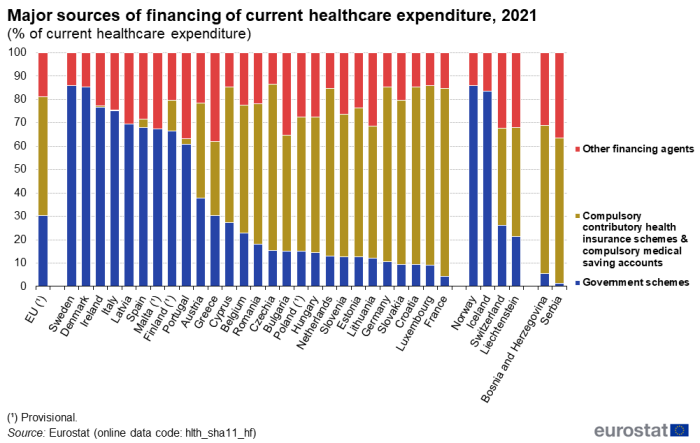
(% of current healthcare expenditure)
Source: Eurostat (hlth_sha11_hf)
Table 2 provides a similar analysis of healthcare expenditure by financing scheme, but with more detail concerning other financing schemes.
The third largest source of healthcare funding in the EU was household out-of-pocket payments, with a 14.5 % share in 2021. This was generally the second or third highest share in most EU Member States, accounting for one third or more of total healthcare expenditure in Bulgaria (34.0 %) and Greece (33.3 %). Cyprus, Croatia, the Netherlands, France and Luxembourg were the only EU Member States where household out-of-pocket payments accounted for less than one tenth of healthcare expenditure, with shares ranging from 9.9 % to 8.9 %.
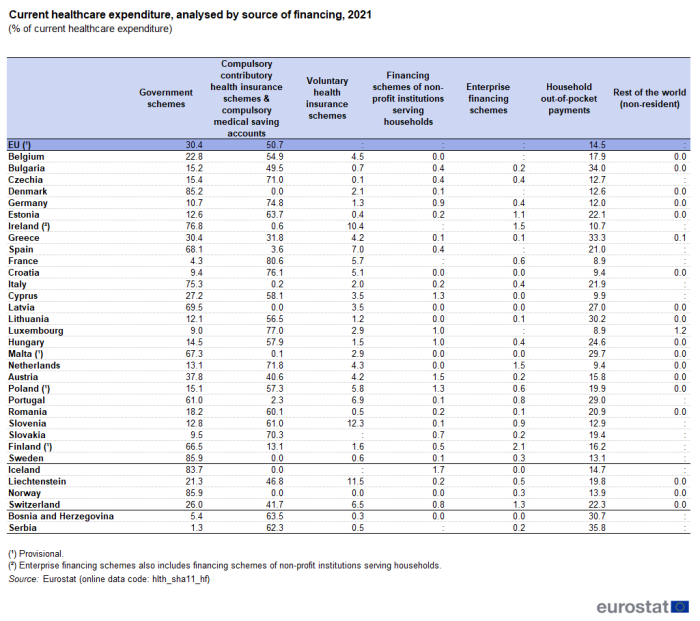
(% of current healthcare expenditure)
Source: Eurostat (hlth_sha11_hf)
Voluntary health insurance schemes generally represented a small share of healthcare financing in the EU in 2021. Their relative share peaked at 12.3 % in Slovenia, followed by 10.4 % in Ireland; the next highest share was 7.0 % in Spain. There were five EU Member States where voluntary health insurance schemes provided less than 1.0 % of the finance for healthcare expenditure in 2021, with the lowest share recorded in Czechia (0.1 %).
The final analysis concerning financing (see Figure 2), shows the same sources of financing as in Table 2, but presented as values per inhabitant in purchasing power standards (PPS) rather than as a share of all healthcare expenditure. When expenditure is expressed in PPS, the expenditure data account for differences in price levels between the EU Member States. This analysis shows how much is spent, on average, per inhabitant from each of the different sources. The total for all sources (the overall height of each stacked column) shows the overall average expenditure per inhabitant. To put this in perspective, the EU Member States, the EFTA countries and Serbia have been ranked based on their overall level of current healthcare expenditure relative to GDP.
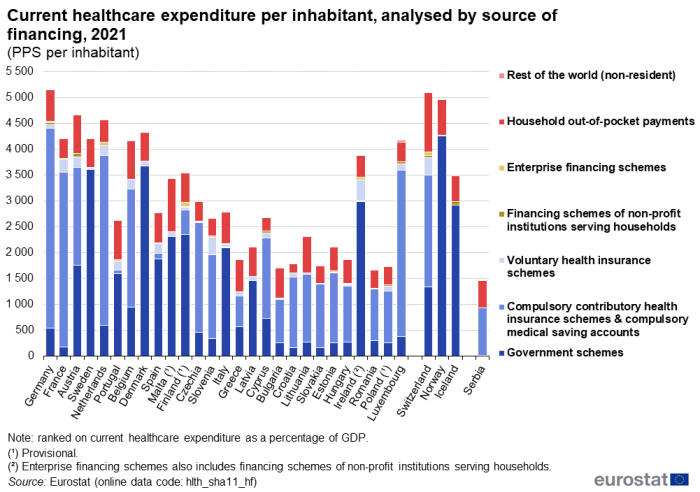
(PPS per inhabitant)
Source: Eurostat (hlth_sha11_hf)
Healthcare expenditure by function
Curative and rehabilitative care services accounted for more than half of current healthcare expenditure in all but three of the EU Member States in 2021
The functional patterns of healthcare expenditure presented in Figure 3 and Table 3 show that curative and rehabilitative care services incurred more than 50.0 % of current healthcare expenditure in 2021 in the vast majority of EU Member States. The exceptions were Germany, the Netherlands and Malta, where the shares were between 46.9 % and 48.6 %. The average for the EU was 51.6 %. By contrast, at the upper end of the range, more than two thirds of current healthcare expenditure in 2021 was incurred by curative and rehabilitative care services in Cyprus (68.7 %), while Portugal and Poland also recorded shares that were above 60.0 %.
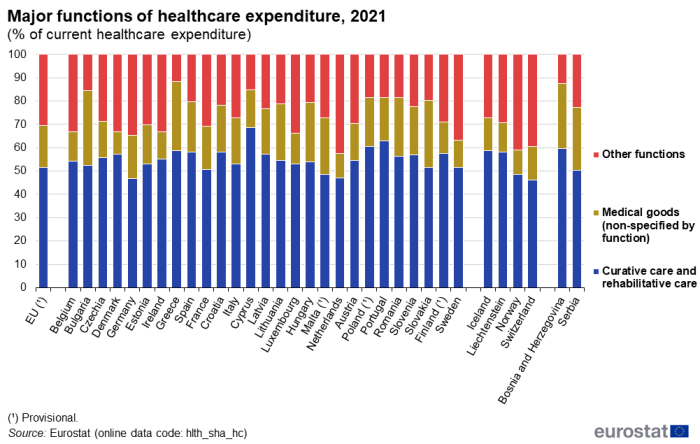
(% of current healthcare expenditure)
Source: Eurostat (hlth_sha_hc)
Medical goods accounted for just under one fifth of healthcare expenditure in 2021
Medical goods (non-specified by function) were the second largest function in the EU in 2021, with a 17.9 % share of current healthcare expenditure. There was a substantial variation between the EU Member States in terms of the share of expenditure used for these medical goods. The lowest shares were recorded for Denmark (9.7 %) and the Netherlands (10.4 %). By contrast, the highest share – where medical goods accounted for close to one third of current healthcare expenditure – was recorded for Bulgaria (32.0 %).
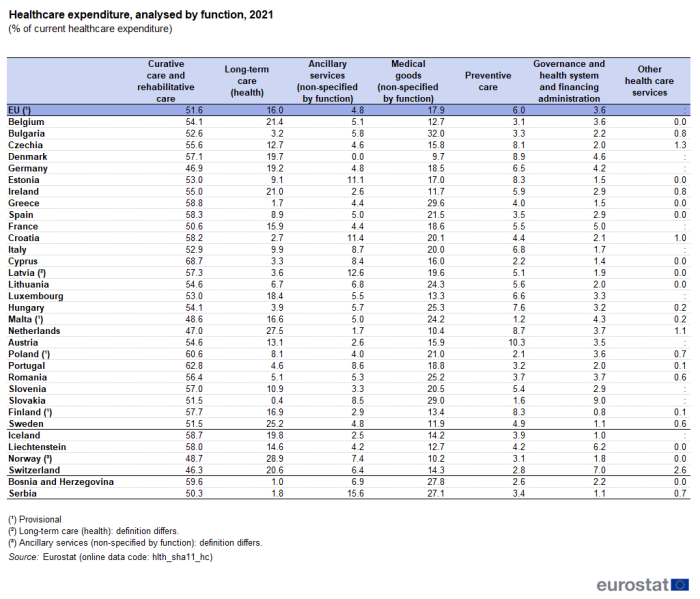
(% of current healthcare expenditure)
Source: Eurostat (hlth_sha11_hc)
The proportion of healthcare expenditure incurred by long-term healthcare was 16.0 % in the EU in 2021: more information about this function is given in a special focus below.
The fourth largest function was expenditure for preventive care, which averaged 6.0 % of current healthcare expenditure in 2021 in the EU. Among the EU Member States, the share ranged from 1.2 % in Malta to 10.3 % in Austria. The next largest function was ancillary services (such as laboratory testing or the transportation of patients), which accounted for 4.8 % of healthcare expenditure in the EU in 2021. The share of these services exceeded 10.0 % in Latvia, Croatia and Estonia. Expenditure related to governance and health system and financing administration averaged 3.6 % in the EU in 2021 and generally ranged from 0.8 % in Finland to 5.0 % in France; Slovakia was an exception, as the share of expenditure related to governance and health system and financing administration reached 9.0 %.
Long-term healthcare expenditure accounted for more than a quarter of current healthcare expenditure in the Netherlands and Sweden in 2021
As noted above, services related to long-term healthcare accounted for 16.0 % of current healthcare expenditure in the EU in 2021. This share was below 10.0 % in 14 of the EU Member States (see Figure 4). Relatively low shares could be due to the main burden of long-term healthcare residing with family members, with no payment being made for providing these services. On the other hand, more than one fifth of healthcare expenditure was attributed to long-term healthcare in Ireland and Belgium, with this share exceeding one quarter in Sweden and the Netherlands (25.2 % and 27.5 %, respectively). Among the EFTA countries, a relatively high share (28.9 %) was recorded in Norway (higher than in any of the Member States). It should be noted that it can be difficult to separate the medical and social components of expenditure for long-term care, leading to an inevitable impact on cross-country comparisons.
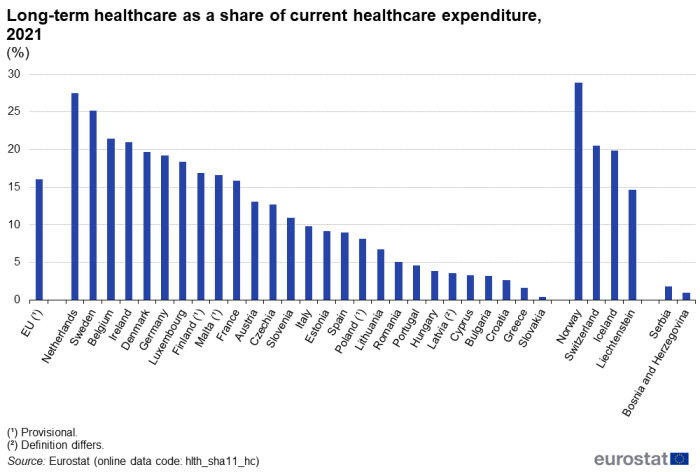
(%)
Source: Eurostat (hlth_sha11_hc)
Healthcare expenditure by provider
In expenditure terms, hospitals were the main providers of healthcare in most EU Member States in 2021
An analysis of current healthcare expenditure by provider is shown in Figure 5 and Table 4. It should be borne in mind that healthcare providers classified under the same group do not necessarily perform the same set of activities. For example, hospitals may offer day care, out-patient, ancillary or other types of services, in addition to in-patient services.
Hospitals accounted for the highest proportion (36.0 %) of healthcare expenditure in 2021 in the EU. Among the EU Member States, the share of current healthcare expenditure related to hospitals ranged from 27.0 % of the total in Germany to 50.8 % in Croatia and 53.0 % in Cyprus. Only Germany and Latvia reported that hospitals did not have the highest share of healthcare expenditure, as ambulatory health care providers accounted for a greater share of total healthcare expenditure. Among the EFTA countries, Liechtenstein reported a particularly low share of healthcare expenditure on hospitals (8.8 %), reflecting the fact that some healthcare activities provided by specialised hospitals are only available abroad.
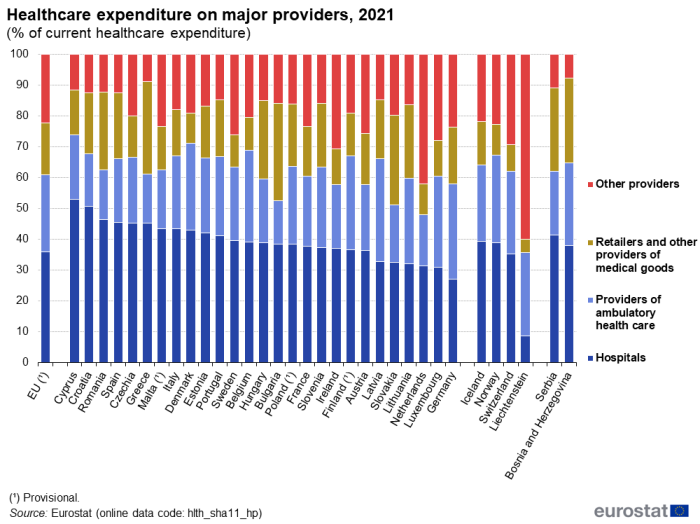
(% of current healthcare expenditure)
Source: Eurostat (hlth_sha11_hp)
The second largest healthcare provider (in expenditure terms) was generally that of ambulatory health care providers. Their share of current healthcare expenditure in 2021 averaged 25.1 % in the EU and ranged from 14.1 % in Bulgaria to 33.4 % in Latvia.
The share of current healthcare expenditure accounted for by retailers and other providers of medical goods averaged 16.6 % in the EU in 2021. However, their share varied greatly between the EU Member States, from 9.7 % in Denmark and 9.9 % in the Netherlands to 29.0 % in Slovakia, 30.2 % in Greece and 31.5 % in Bulgaria.
Table 4 gives information on the relative size of the providers shown in Figure 5 as well as more detailed information on the shares of other providers. By far the largest of the other providers was residential long-term care facilities. Among the EU Member States, the share of residential long-term care facilities within current healthcare expenditure varied from 0.3 % in Bulgaria to 17.2 % in Sweden, with the share in the Netherlands above this range at 27.5 %.
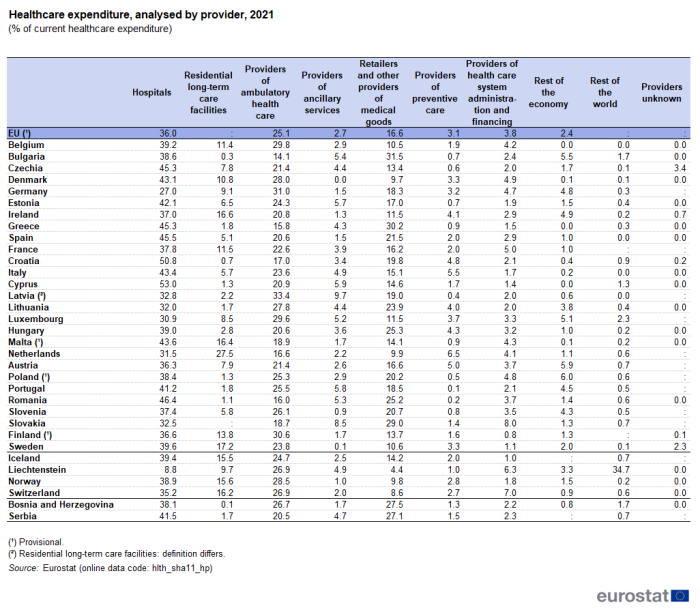
(% of current healthcare expenditure)
Source: Eurostat (hlth_sha11_hp)
Source data for tables and graphs
![]() Healthcare expenditure statistics by functions, providers and financing schemes: tables and figures
Healthcare expenditure statistics by functions, providers and financing schemes: tables and figures
Data sources
The data for the EU, Malta, Poland and Finland for 2021 are provisional.
Tables in this article use the following notation:
- a colon ' : ' is used to show where data are not available.
Key concepts
Current healthcare expenditure quantifies the economic resources allocated to health functions, excluding capital investment. Healthcare current expenditure is primarily concerned with healthcare goods and services that are consumed by resident units, irrespective of where that consumption takes place (it may be in the rest of the world) or who is paying for it. As such, exports of healthcare goods and services (to non-resident units) are excluded, whereas imports of healthcare goods and services for final use are included.
Medical goods are split into i) pharmaceuticals and other medical non-durable goods and ii) therapeutic appliances and other medical durables. This category aims to include all consumption of medical goods where the function and mode of provision is not specified. It includes medical goods acquired by the beneficiary either as a result of prescription following a health system contact or as a result of self-prescription. It excludes medical goods consumed or delivered during a health care contact that are prescribed by a healthcare professional.
Long-term healthcare consists of a range of medical and personal care services that are consumed with the primary goal of alleviating pain and suffering and reducing or managing the deterioration in health status in patients with a degree of long-term dependency. The aim of long-term social care is to provide services and support, by formal and informal care givers, to individuals who, for reasons of disability, illness or other dependency, need help to live as normal a life as possible. Social care covers a wide range of services, including professional advice and support, accommodation, various types of assistance in carrying out daily tasks, home visits, home help services, provision of meals, special equipment, house adaptation for disabled persons, as well as assessment and care management services. There may be a mixed economy of health and social care provision and this mix of services can make it difficult to separate expenditure between health and social components. For the purpose of this article, the analysis of long-term healthcare (as shown in Figure 4) is composed solely of the health component.
System of health accounts – methodology
Eurostat, the Organisation for Economic Cooperation and Development (OECD) and the World Health Organization (WHO) established a common framework for a joint healthcare data collection exercise. The data collected relates to healthcare expenditure following the methodology of the system of health accounts (SHA).
The SHA shares the goals of the system of national accounts (SNA): to constitute an integrated system of comprehensive, internally consistent and internationally comparable accounts, which should as far as possible be compatible with other aggregated economic and social statistical systems. Health accounts provide a description of the monetary flows related to the final consumption expenditure on healthcare goods and services. Health accounts are used in two main ways: internationally, where the emphasis is on a selection of comparable expenditure data; nationally, with more detailed analyses of healthcare spending and a greater emphasis on comparisons over time.
For more detail on health accounts, see A system of health accounts, 2011 – revised edition. The core set of SHA tables addresses three basic questions: i) what kinds of healthcare goods and services are consumed, ii) which healthcare providers deliver them and, iii) which financing schemes are used to finance the expenditure?
Healthcare expenditure is recorded in relation to the international classification for health accounts (ICHA), defining:
- healthcare expenditure by financing schemes (ICHA-HF) – classifies the types of financing arrangements through which people obtain health services; healthcare financing schemes include direct payments by households for services and goods and third-party financing arrangements;
- healthcare expenditure by function (ICHA-HC) – details the split in healthcare expenditure following the purpose of healthcare activities – such as, curative care, rehabilitative care, long-term care (health), or preventive care;
- healthcare expenditure by provider (ICHA-HP) – classifies units contributing to the provision of healthcare goods and services – such as hospitals, residential facilities, ambulatory health care services, ancillary services or retailers of medical goods.
Healthcare expenditure – legal basis
Commission Regulation (EU) 2021/1901 of 29 October 2021 as regards statistics on health care expenditure and financing is the legal basis for data collection according to SHA 2011 methodology for healthcare expenditure. The regulation applies to data from reference year 2021.
Commission Regulation (EU) 2015/359 of 4 March 2015 implementing Regulation (EC) No 1338/2008 as regards statistics on healthcare expenditure and financing applies to data from reference year 2014 to 2020.
Statistics on healthcare expenditure are documented in a background article which provides more information on the scope of the data, the legal framework, the methodology employed, as well as related concepts and definitions.
Context
Health systems across the globe are developing in response to a multitude of factors, including new medical technology and improvements in knowledge; new health services and greater access to them; changes in health policies to address specific diseases and demographic developments; new organisational structures and more complex financing mechanisms. However, access to healthcare and greater patient choice is increasingly being considered against a background of financial sustainability.
The European Commission adopted a Strategic Plan for the period 2020–2024. In order to improve the quality and effectiveness of public expenditure and contribute to prosperity and social cohesion, the European Commission seeks to provide expertise on health systems and support actions that help prevent and reduce the impact of ill-health on individuals and economies, while encouraging and supporting innovation and the uptake of modern technologies for better care delivery and cost-effectiveness.
The Directorate-General for Health and Food Safety has constituted a list of 88 European core health indicators (ECHIs) for monitoring progress in relation to health policy and broader objectives. Among these, it recommends specifically following developments for:
Direct access to
Online publication
Methodology
Healthcare expenditure statistics articles
General health statistics articles
- Health (hlth), see:
- Health care (hlth_care)
- Health care expenditure (SHA 2011) (hlth_sha11)
- A system of health accounts 2011 – revised edition
- Healthcare expenditure (SHA 2011) (ESMS metadata file – hlth_sha11_esms)
Implementing legislation